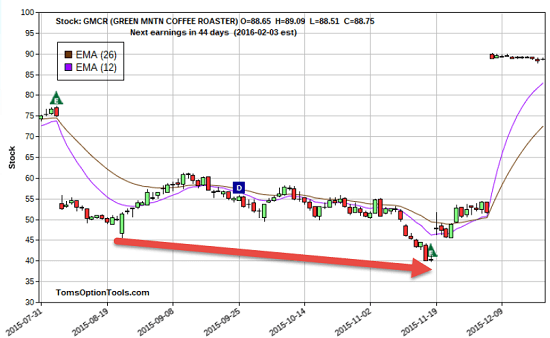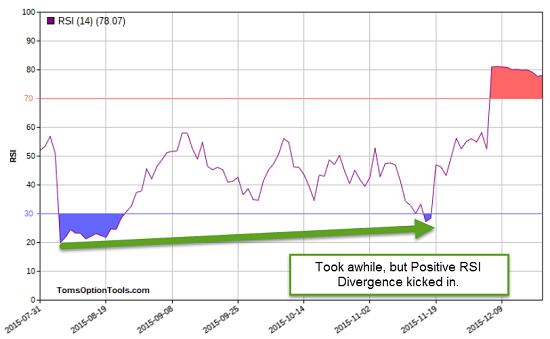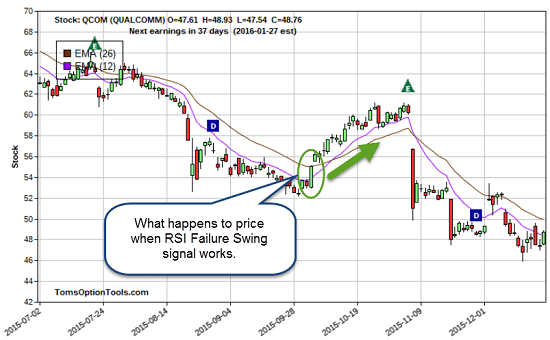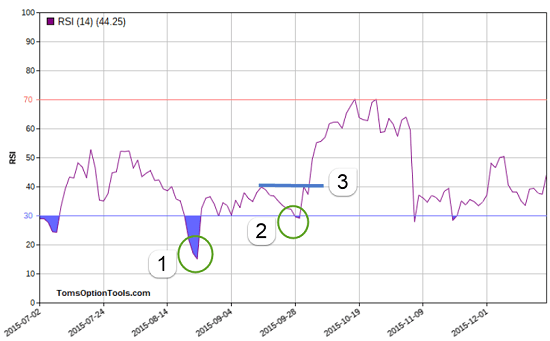"Trust your gut."
At some point in your life, you may have heard this from a parent, a teacher, a friend... you may have even told yourself this...
The idea being... you can never be wrong and can never lose when you trust your gut.
But here's how this thinking can actually destroy you.
When it comes to options trading, trusting your gut can cost you everything.
And MAKING MONEY is my No. 1 goal.
Actually, I don't believe in a trade unless I will - at the very least - DOUBLE my money.
But there's a right way and a wrong way to do it.
The wrong way may reward you with some wins here and there, but will ultimately earn you a lifetime of losses.
The right way will spoil you with a lifetime of wealth.
And to get there, you simply need to be able to predict when a stock's price is about to move.
Last week, I gave you the tool for measuring the market trend - the relative strength index (RSI).
Today, I'm going to show you how to use the RSI to predict where that trend is going - and when it's about to change direction.
Let's begin...
Conflict Can Be a Good Thing... and Lead to HUGE Profits
The developer of the RSI, James J. Wilder, was a strong believer that divergence between the RSI and a stock's price is a very strong indicator for a turning point or reversal for that stock.
While the RSI measures the trend, divergence tells you where that trend is going and predicts the moment when a stock will turn.
It occurs when the price action of a stock (underlying asset) conflicts with the data that a technical indicator provides. In this case, we're talking about a disagreement between the price action of a stock and the data that the RSI provides.
Now we know that the market can change at any time, but you can recognize and react the right way by knowing that there's about to be a shift in the price action. This will lead to increased profitability in your trades.
There are two types of divergence that you will want to look for:
Bullish divergence: When the stock price, the underlying asset, makes a lower low and the RSI makes a higher low. This gives indication momentum is gaining steam because the RSI doesn't confirm the lower low.
Bearish divergence: When the stock price, the underlying asset, makes a higher high and the RSI makes a lower high. This gives indication momentum is losing steam because the RSI doesn't confirm the higher high.


No matter how long it took or takes, keep an eye out for the price and RSI relationship. When you get a bullish move out of an oversold zone like in the visual example above, and it is backed up with a positive divergence, a chance for a higher move in the price of the stock has a much greater chance of happening.
Now it's important for me to point out that you may get multiple divergences in up and down trends. With that understanding, you should know this isn't necessarily the best setup to use with the RSI. A better way to use the RSI is by looking for what is called a failure swing.
Bank Higher Profits by Detecting a Trend Reversal
Wilder considered failure swings strong indications of an impending reversal as well. I reiterate, failure swings are based on the RSI itself, not price action.
Failure swings occur when a technical indicator - the RSI - is in an overbought or oversold zone and signals that the current trend is weakening... and a reversal is highly probable.
They can provide higher reward opportunities because you will know what to do when the market is going the way you expected and when it goes the complete opposite direction.
Like divergence, there are two types of failure swings:
Bullish failure swing: When the RSI comes out of the oversold zone by rising above the 30 line, retraces back to and holds at or above the 30 line, then fails to reach the same level that it did before and turns downward again (forms an M pattern) then sees the RSI line break above its recent RSI high. Do not look for a divergence in price when this is forming, as this signal is the focus, not price.
Bearish failure swing: When the RSI comes out of an overbought zone by crossing below the 80 line, retraces back up to and holds at or below the 80 line, then fails to reach the same level that it did before and turns upward again (forms an M pattern) then sees the RSI line break below its recent RSI low. Do not look for divergence in price when this is forming, as this signal is the focus, not price.
That failure to make the higher high or lower low is the failure swing and indicates that an uptrend or a downtrend may be ending and reversing soon. Failure swings are solely focused on the RSI and basically ignore the concept of positive or negative divergences.
That said, in the RSI screen for Qualcomm Inc. (Nasdaq: QCOM) below, I have highlighted the following points to show you how the failure swing setup works - and what it looks like:
- The RSI is below the 30 line and coming out of the oversold zone by crossing above the 30 line.
- The RSI comes back to and holds at the 30 line, showing a bit of strength in the oscillator.
- The RSI line works its way above a recent RSI line high, indicating a potential reversal to the upside.


The RSI has lasted for over 30 years. In that time, much has been written about it and there have been many variations to it.
The RSI can indicate the strength of the existing trend, and traders use it to see if a stock is oversold or overbought. They next key on whether the momentum that propelled a stock into these areas or zones is reversing course - and capitalize on these price moves.
As I said earlier, there's a right way and a wrong way to capitalize on market trends.
As a trader and a teacher, I always say that when setting up your options trades, it's best to know your expected price move in a stock and the time frame it can take to get there.
The RSI does not offer that, but you can look to initiate a bullish setup on a move out of the oversold zone and anticipate selling when it gets to an overbought reading to start.
The trick to using the RSI is recognizing failure swings and divergence and using them to enter high-income trades.
[mmpazkzone name="in-story" network="9794" site="307044" id="137008" type="4"]
Subscribers to my Money Calendar Alert can see the price expectancy and time frame of that price move. The RSI - as well as any number of similar momentum oscillators - could be a complement to it.
Follow us on Twitter @moneymorning or like us on Facebook.
Boost Your Trades with This Signal: By comparing the ratio between a stock's recent gains and losses, this signal helps traders accurately read trends to find ideal setup points on high-income trades. It's the absolute best momentum indicator you can have in your trader's toolbox...
About the Author
Tom Gentile, options trading specialist for Money Map Press, is widely known as America's No. 1 Pattern Trader thanks to his nearly 30 years of experience spotting lucrative patterns in options trading. Tom has taught over 300,000 traders his option trading secrets in a variety of settings, including seminars and workshops. He's also a bestselling author of eight books and training courses.



